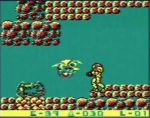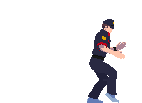
This site is getting a little bit too PC-loving. Come on guys, did we really need two Descent articles in a row? (The answer is obviously yes, but it's a rhetorical question.) What about the handheld love? What about... Metroid II: The Return of Samus.
In the far-flung futuristic year 20X5, the surprisingly not male Samus Aran is dispatched to perform a mass genocide on planet SR388, killing off every living creature she comes across. It is up to you stop this maniac at once make sure she performs her duties with the utmost precision!
Metroid II: The Return of Samus is an often overlooked game by Metroid fans, probably due to it's being nestled between the first game, and what is arguably the greatest side scrolling action game ever, Super Metroid. But Metroid II definitely does Metroid like no other Metroid does Metroid.
Metroid games have now come to be known for their eerie settings, dark atmosphere and minimalistic style, but Metroid II paved the way for this. Starting with the box art, a picture of Samus kneeling on a barren wasteland, her arm cannon still smoking, with a clear sky full of stars above. Even when you put the cartridge into your Game Boy, there are no "Presented by" screens, just straight to the title screen, the single note beeping, flaring into existence, then echoing away on this empty planet.
Don't think this game is un-polished, though. As soon as you start a new game, you see Samus standing under her beautifully detailed four-color ship. If you play on a Super GameBoy or a Game Boy Color, you'll get an extra treat, as the background tiles are all colored in shades of blue, while Samus, her ship, and various enemies are orange and red. Samus' sprite is just gorgeous, and unlike the first Metroid game, it no longer looks like a weird orange one-piece pajama.
The large area you start in gives you no choice but to move to the right, into the twisting labyrinthian caves deep below the planet's surface. This is one of those games that takes it's time starting, and lets you learn how the game works. You're confronted with several simple enemies very easily, and soon come to a fork in the road. Of course, one direction leads to a dead end (Or is it?) and the other leads to your first real opponent.
And then you see it. I can not describe to you the feeling of pure dread I felt in my very core when I first saw that Metroid. Right off the bat, there's one there, and I know there's no way I can beat it, not without the Ice Beam—but wait! It's mutating. The fear wells up inside me, but I know there is no escape. The only thing to do is pull out your missiles, and begin firing. Luckily for Samus, these metroids are weaker than their Zebethian counterparts, and the creature is quickly destroyed. And when it lets out it's final cry, an earthquake hits. Your adventure has begun.
Maybe I'm just not as good at it, but I found this game to not quite have the open feeling of the first game or of Super Metroid. I felt like it was a bit more linear, but not nearly as bad as some of the newer Metroid games. As you traverse the depths of SR388, you will meet a multitude of winding, twisting paths, forks, and of course acid and metroids. The feeling of being a lone explorer is in full effect here, especially with the Game Boy's small, cramped screen, sometimes hiding massive caverns full of enemies, power-ups and secret areas. One of the greatest advancements of this game was the Spider-Ball, which gave caverns an extra dimension, and made even the walls and ceiling explorable territory.
And all the while, the dot-matrix speaker produces an ambient soundtrack that puts you straight into Samus' visor. At first the music starts off with all the thrill and excitement of a new adventure, but as you delve deeper into the dark maze of the planet, the music quickly becomes more mysterious, almost foreboding. In several rooms, the "music", if it can so be called, is simply a strange pattern of beeps that can only be described as the musical equivalent of the hair on your arm prickling. Some areas have no music at all, which may seem like an odd choice, but even that adds to the spooky, distressed atmosphere of the game. There are actually very few tracks in this game, but they are all used superbly to illustrate the feeling of being alone on a cold, harsh planet where everything is out to get you.
If the first Metroid game set the standard for Metroid games to follow, being a shining example of what a game on that console should be, Metroid II solidified it as a tradition. The kind of care and attention that went into crafting this masterpiece is rarely seen in handheld games made in an era of NES knock-offs, and that makes Metroid II all the better.
Lazlo Falconi owns and operates QualityRoms and is a good friend of Retro of the Week.



